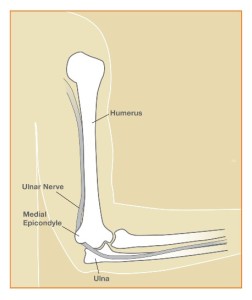Cubital tunnel syndrome is a compression of the ulnar nerve at the elbow. This nerve is the same one we call the “Funny Bone” that gets hit occasionally and is not so funny. When this nerve is chronically pinched or stretched, cubital tunnel syndrome can develop.
Cubital Tunnel Syndrome Symptoms
Symptoms include numbness or tingling in the ring and small fingers, pain in the forearm, and/or weakness in the hand. Symptoms are worse when the elbow is flexed, or bent. This stretches the nerve over the medial epicondyle of the elbow. Activities that usually aggravate symptoms are sleeping with elbows bent, talking on the phone, or direct pressure over the nerve.
Treatment for Cubital Tunnel Syndrome
Activity modification – Avoiding activities that cause symptoms can alleviate aggravation on the site and provide a chance to heal. This usually involves noticing positions where the elbow is flexed and repositioning with a straighter elbow.
Splinting – A splint can be worn at night to keep the elbow straight and avoid excessive bending (flexion).
**It is important not to ignore the symptoms of cubital tunnel syndrome. It is recommended patients undergo surgery prior to experiencing constant symptoms or weakness. These symptoms are caused by nerve damage. These symptoms may not be completely relieved, but we can prevent them from worsening.
Cubital Tunnel Syndrome Surgery
If non-surgical forms of treatment do not relieve the symptoms, surgery may be recommended. This surgery involves an incision over the area of the nerve and releasing the tight structures that surround it. Surgery can be done as an outpatient procedure and recovery does not require any splinting.
Surgery recovery involves limiting lifting to a couple pounds for a few weeks after surgery. In most cases, elbow motion is allowed immediately after surgery.

